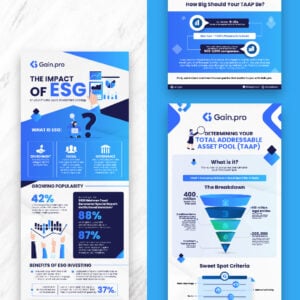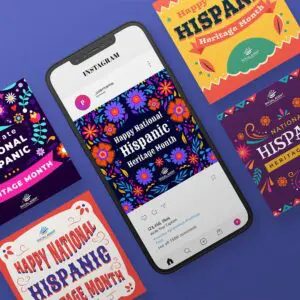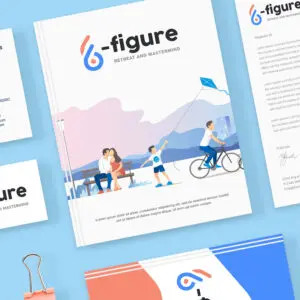
Ready to master the ins and outs of Google Display Network ad specs? You’ve come to the right place!
Navigating the world of online advertising can feel like trying to hit a moving target, especially with Google’s constant updates and guidelines. But don’t worry – we’ve got your back!
We’ve put together a simple, up-to-date cheat sheet that covers everything you need to know about the latest Google Display Ads sizes. It’s your go-to guide for creating ads that not only look fantastic but truly connect with your audience.
From choosing the right image sizes to designing ads that grab attention (pro tip: Penji can help), we’re covering all the bases. So, let’s get started and make sure your ads shine!
What is Google Display Network?
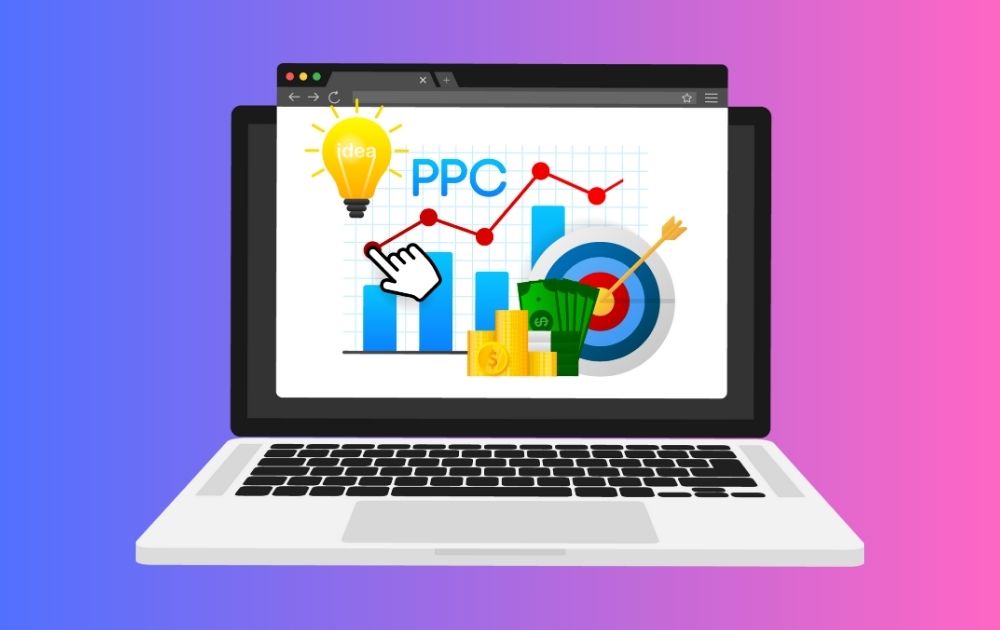
Google Display Network is a vast ad network that allows users to place display ads on millions of websites, mobile apps, and video content across the internet.
It is a platform for advertisers to reach their target audiences by creating visually appealing ads that include images, videos, and text. Also called GDN, the network uses contextual targeting, meaning ads are displayed on websites or mobile apps relevant to the advertiser’s product or service. GDN offers various targeting options, including demographics, interests, topics, and geo locations. That said, these target options ensure your ads are displayed to the right audience.
With GDN, users can increase brand awareness, drive website traffic, and generate leads and conversions. For instance, many of our clients here at Penji ask us to create display ad images for them. After all, they know just how a professionally-made ad creative can help lead audiences through the marketing funnel.
In Google Ads, display campaigns let users reach a relevant audience through visually-engaging ads. These ads are served to audiences as they browse websites and apps, including Google-owned properties like YouTube.
What are the Benefits of a Google Ads Display Campaign?
There are many benefits to using display ads on the Google Display Network. Here are some of the key advantages:
- Wide reach. Display campaigns can reach audiences worldwide, including 35 million websites and apps. As a result, a display campaign will allow you to expand your reach beyond just Google Search. To ensure that you’re using the right platform, you may want to review the difference between Google Ads vs. Facebook Ads and other platforms to advertise online.
- Targeting options. GDN also offers various targeting options, including demographics, interests, topics, and geographic locations. Because of these options, you can reach the right audience with your ads and increase the chances of conversions.
- Multiple ad formats. As mentioned above, GDN supports various ad formats, including text, image, video, and interactive ads. That said, this flexibility and the choice among various Google Display ads sizes allows you to engage your target audience effectively.
- Cost-effective. Display ads on GDN can be cost-effective, with flexible bidding options and low minimum budgets. You can also track the performance of your ads and adjust your strategy based on results to optimize your campaigns and maximize your return on investment.
- Brand awareness. Display ads can help increase brand awareness by placing ads on high-traffic websites and mobile apps relevant to your target audience. It goes without saying that Ttis can help your business gain visibility and credibility in your industry.
What are the Specs for Uploaded Google Display Ads?
What is the image size for Google Display Network? The answer depends on the type of ad you want to place on the network. For starters, here are the formats and maximum size you can upload:
File types
- Formats GIF, JPG, PNG
- Max. size 150KB
Here are the Google Display ads sizes, as stated in Google Ads. We’ve also attached a Google display ad sizes cheat sheet for every category for visual reference.
Square and rectangle
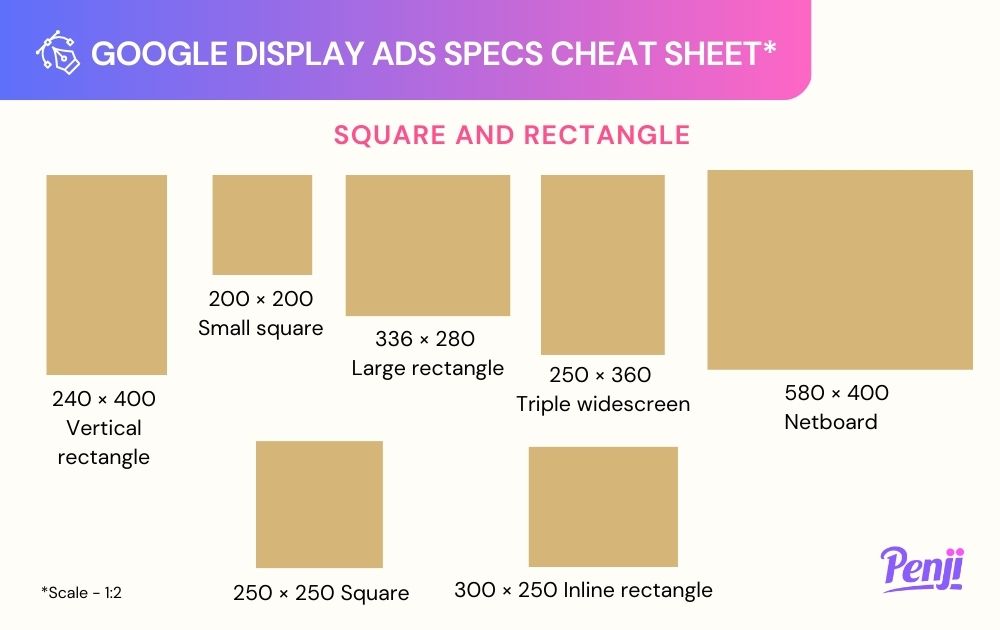

- 200 × 200 Small square
- 240 × 400 Vertical rectangle
- 250 × 250 Square
- 250 × 360 Triple widescreen
- 300 × 250 Inline rectangle
- 336 × 280 Large rectangle
- 580 × 400 Netboard
Skyscraper
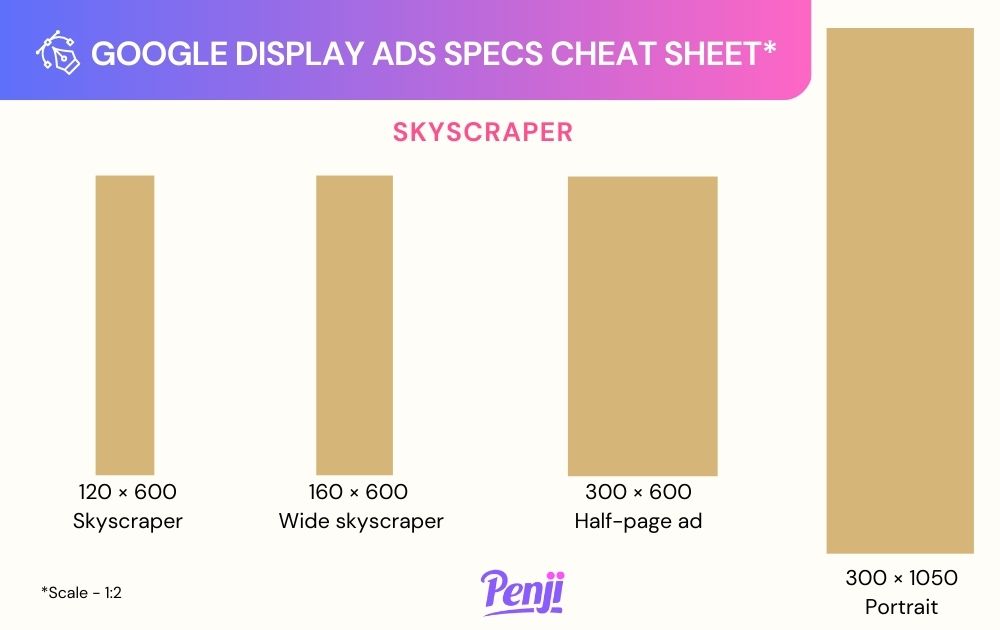

- 120 × 600 Skyscraper
- 160 × 600 Wide skyscraper
- 300 × 600 Half-page ad
- 300 × 1050 Portrait
Leaderboard
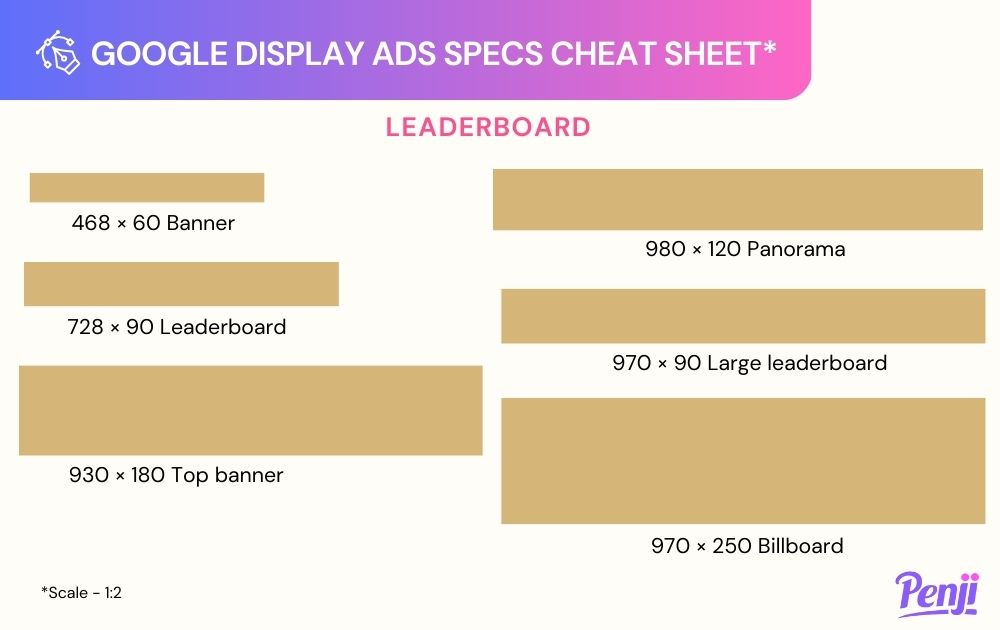

- 468 × 60 Banner
- 728 × 90 Leaderboard
- 930 × 180 Top banner
- 970 × 90 Large leaderboard
- 970 × 250 Billboard
- 980 × 120 Panorama
Mobile
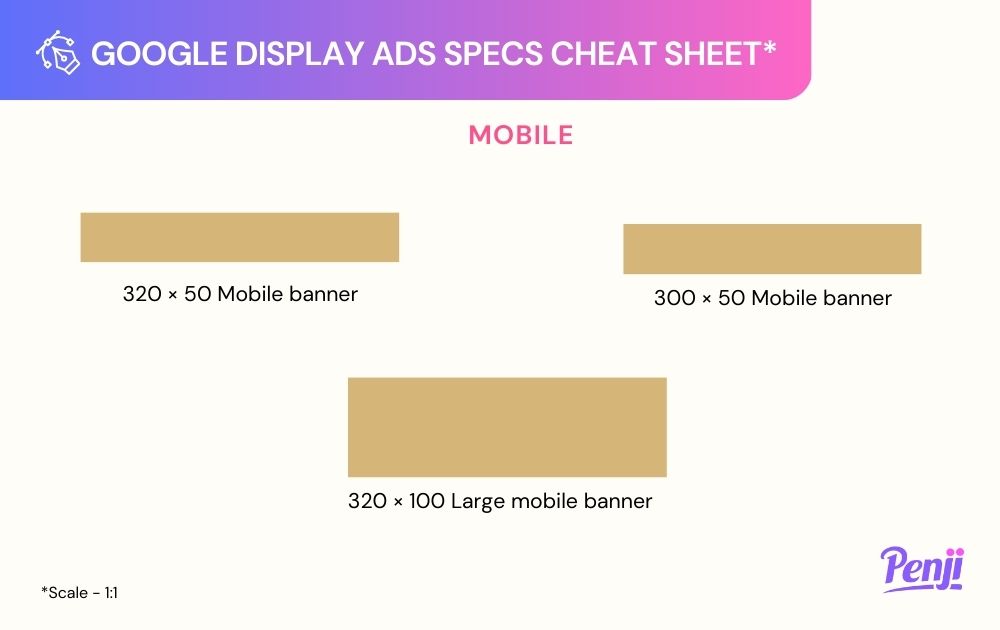

- 300 × 50 Mobile banner
- 320 × 50 Mobile banner
- 320 × 100 Large mobile banner
Knowing Google Display ads sizes for GIF or animated ads is vital. For instance, the animation length must not exceed 30 seconds. This means advertisers must create concise ads and get their message across quickly.
Additionally, while animated ads can be looped, the animations must stop after 30 seconds. Finally, the speed of the animation is slower than 5 FPS. This prevents the animated GIF from being too distracting or annoying for users.
What resolution is best for Google Ads?
Aside from using the most common Google display ad sizes, the right resolution is also crucial. Google recommends a relatively high resolution for the ad, such as:
- 1600 x 1200
- 1600 x 900
- 1280 x 1024
- 1152 x 864
It’s vital to remember that if the ad resolution is 1024 by 768 pixels or lower, you may not see the entire screen of Google Ads Editor.
What are the best-performing Google display ad sizes?
If you’re wondering about the best Google Display Network ad specs or size, you don’t have to look further than the search engine’s internal data. Google ad sense mentions the following as top-performing ad sizes:
- 300 x 250 medium rectangle
- 336 x 280 large rectangle
- 728 x 90 leaderboard
- 300 x 600 half page
- 320 x 100 large mobile banner
Whatever Google display ad size you intend to use, you need to have relevant visuals to help capture the attention of potential customers. By using designs crafted by professional designers, you increase your chances of getting more clicks, engagement, and conversion. By outsourcing your ad image to design experts, you’ll have more time and energy to optimize your ads and review analytics.
Google Display Ads vs. Responsive Display Ads
Understanding the difference between traditional display ads and responsive display ads is key to crafting successful online campaigns.
While both play pivotal roles in reaching target audiences, their functionalities and adaptabilities differ significantly.
Google Display Ads
Display ads are predefined in terms of banner ad size and format. They require advertisers to create separate ad assets for each size and placement. That said, this approach offers control over the exact look of the ad – including Google Display ads sizes – but demands more resources for creation and management.
In this context, display ads are ideal when you need to maintain strict brand guidelines or when targeting a platform with known dimensions.


Responsive Display Ads
On the other hand, responsive display ads automatically adjust their size, appearance, and format to fit available ad spaces across different devices and screen sizes. This flexibility is a crucial advantage in today’s multi-device world, where users access content on a variety of screens.
Also, this type of ads can streamline the ad creation process, as you only need to provide assets (images, headlines, logos, and descriptions). After which, Google’s algo does the rest.
Here’s a quick comparison:
- Creation and Management. Display ads require creating multiple versions for different sizes, while responsive ads adapt automatically, reducing the workload.
- Flexibility. Responsive ads offer higher flexibility, adjusting to various screen sizes and placements, unlike fixed-size display ads.
- Reach and Efficiency. Responsive ads can appear in more ad spaces, potentially increasing reach and efficiency of the campaign.
- Control. Display ads provide more control over the exact appearance, while responsive ads rely on Google’s algorithm for the final layout.
The choice between them depends on the specific goals and resources of your advertising campaign.
Some Google Display Ads You’ll Want to Copy
Once you know how to benefit from Google Display Network, you’ll be thrilled to create ads that catch the attention of your target audience. Here are some of the best examples of Google display ads:
1. SEMRush
In this ad, SEMRush uses a font with an eye-catching blue background. The bold orange and pink illustrations make it more colorful enough to draw attention. This ad uses a simple yet powerful combination of two elements. It states the value through the phrase “skyrocket your marketing” and provides social proof because of “like our clients did.”
2. Apple TV Gift Card Ad
It is often effective when you keep things simple, like this Apple display ad example. This leaderboard ad for gift cards nails it with simplicity. Vibrant cards, four words of copy – less is more! It taps into “stay-in” trends, offering the perfect at-home entertainment gift. While “Learn More” isn’t sensational, the contrast and overall design shine. This ad is worth emulating!
3. Conversica
Conversica takes a bold approach with its display ads, using a large vertical format that grabs attention and cuts through “banner blindness.” But instead of showcasing their company, they smartly offer valuable research on virtual assistants in sales. This intriguing offer, rather than a hard sell, entices viewers to learn more, making it an effective and engaging ad.
Tips to Get The Most Out of Google Ads
Here are some essential tips to ensure your Google Ads are performing at their best:
- Understand Ad Specifications. Familiarize yourself with the latest ad specifications for Google Ads. For instance, you need to know the right dimensions, file sizes, and formats for different types of ads. After all, adhering to these specifications ensures your ads are displayed correctly across various platforms.
- Optimize for Display Campaigns. When setting up display campaigns, it’s crucial to target the right audience. Use Google’s targeting options to narrow down your audience based on demographics, interests, and online behaviors. This targeted approach helps in placing your ads in front of the most relevant audience.
- Leverage Ad Inventory Wisely. Make the most of your ad inventory by choosing the right mix of ad types and placements. Diversify your ad formats to include text, image, and video ads to see which works best for your target audience.
- A/B Testing. Regularly test different elements of your ads, such as headlines, descriptions, and call-to-actions. A/B testing helps in understanding what resonates best with your audience and improves the overall performance of your ads.


- Track and Analyze Performance. Use Google Analytics in conjunction with Google Ads to track the performance of your campaigns. Analyzing metrics like click-through rates, conversion rates, and return on ad spend can provide insights to optimize future campaigns.
- Stay Updated with Trends. The digital advertising landscape is always evolving. Stay updated with the latest trends and best practices in Google Ads to keep your campaigns relevant and effective.
- Professional Design Services. Consider partnering with professional design services like Penji for high-quality ad creatives. Penji offers unlimited graphic design services that can elevate the visual appeal of your ads, making them more engaging and effective.
Ready to take your Google Ads to the next level?
About the author


Carla Deña
Carla is a journalist and content writer who produces stories for both digital and legacy media. She is passionate about creativity, innovation, and helping small businesses explore solutions that drive growth and social impact.
Table of Contents
- What is Google Display Network?
- What are the Benefits of a Google Ads Display Campaign?
- What are the Specs for Uploaded Google Display Ads?
- File types
- Square and rectangle
- Skyscraper
- Leaderboard
- Mobile
- What resolution is best for Google Ads?
- What are the best-performing Google display ad sizes?
- Google Display Ads vs. Responsive Display Ads
- Google Display Ads
- Responsive Display Ads
- Some Google Display Ads You’ll Want to Copy
- 1. SEMRush
- 2. Apple TV Gift Card Ad
- 3. Conversica
- Tips to Get The Most Out of Google Ads

